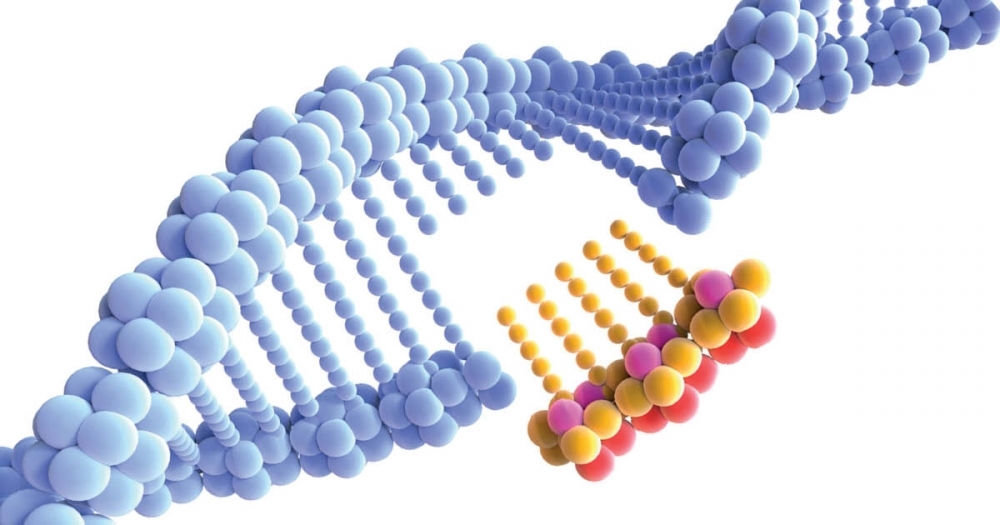

Brazilian researchers are developing a strategy to induce mutations in the gene that encodes ACE-2, the protein used by SARS-CoV-2 to invade human cells. The goal is to disrupt the protein’s interaction with the virus without impairing its function in the organism (image: Alfred Pasieka / Science Photo Library)
Brazilian researchers are developing a strategy to induce mutations in the gene that encodes ACE-2, the protein used by SARS-CoV-2 to invade human cells. The goal is to disrupt the protein’s interaction with the virus without impairing its function in the organism.
Brazilian researchers are developing a strategy to induce mutations in the gene that encodes ACE-2, the protein used by SARS-CoV-2 to invade human cells. The goal is to disrupt the protein’s interaction with the virus without impairing its function in the organism.

Brazilian researchers are developing a strategy to induce mutations in the gene that encodes ACE-2, the protein used by SARS-CoV-2 to invade human cells. The goal is to disrupt the protein’s interaction with the virus without impairing its function in the organism (image: Alfred Pasieka / Science Photo Library)
By Elton Alisson | Agência FAPESP – In Brazil, researchers affiliated with the University of São Paulo’s Ribeirão Preto Medical School (FMRP-USP) and Ribeirão Preto School of Dentistry (FORP-USP) are developing a gene editing strategy to combat COVID-19.
They will use molecular biology and bioinformatics tools to create a system that simulates point mutations in the gene that encodes the protein ACE-2, to which SARS-CoV-2 binds in order to penetrate human cells. Their aim is to destabilize interaction between the virus and cells to prevent infection.
Developed as part of a project supported by FAPESP, the model is described in an article published on Preprints, a platform for papers that have not yet been peer-reviewed.
“The system can simulate the insertion of specific mutations into the region of the gene ACE-2 that encodes the part of the protein that adheres to the virus, without impairing the molecule’s physiological functions,” Geraldo Aleixo Passos, a professor in FMRP-USP and FORP-USP, and principal investigator for the project, told Agência FAPESP.
One of the key functions of the gene ACE-2 is expressing the messenger RNA that regulates the production of angiotensin-converting enzyme 2, which plays an important role in the control of blood pressure.
Any candidate drug for COVID-19 that inhibited this gene could in principle prevent the virus from penetrating cells but might raise the patient’s blood pressure, Passos noted. “Gene editing is a more interesting strategy for interfering with ACE-2 because it would affect only the region of the protein that interacts with the virus, leaving intact the biological mechanism of angiotensin-2 conversion,” he said.
When they analyzed the structural characteristics of the coronavirus’s spike protein and the region of the ACE-2 protein that binds to it and lets it into cells (the N-terminal alpha-helix), the researchers identified amino acid residues that functioned as points of contact between the virus and ACE-2.
“There may be other regions of ACE-2 that interact with SARS-CoV-2, but we focused on the one that’s well-known,” Passos said.
They then used CRISPR/Cas9 – a molecular tool that can insert or delete nucleotides (genetic building blocks) and even entire genes into the genome – to alter codons (triplets of nucleotides in DNA) of the ACE-2 alpha-helix amino acid residues involved in the protein’s interaction with the virus, replacing key amino acids with alanine (Ala).
The researchers confirmed their predictions that the point mutations achieved in this way destabilized and hence weakened the interface interaction between the ACE-2 alpha-helix and the SARS-CoV-2 spike protein while preserving the active core of the ACE-2 protein.
“Our bioinformatics assays proved that gene editing is a promising strategy to combat COVID-19,” Passos said.
The researchers now plan to conduct laboratory experiments in association with groups of virologists.
The graduate students who took part in the study made a video animation to explain the research project. The film was one of the winners in a competition held by the University of São Paulo’s Pro-Rector for Graduate Studies to find the best shorts on COVID-19 research produced by master’s and PhD students at USP.
The article “A CRISPR-Cas9 system designed to introduce point mutations into the human ACE-2 gene to weaken the interaction of the ACE-2 receptor with the SARS-CoV-2 S protein” (doi: 10.20944/preprints202005.0134.v1) by Pedro P. Tanaka, Jadson C. Santos, Ernna H. Oliveira, Natane A. Miglioli, Amanda F. Assis, Ana C. Monteleone-Cassiano, Vitor L. Ribeiro, Max J. Duarte, Mayara V. Machado, Romário S. Mascarenhas, Alex C. Souza, Letícia A. Brito, Letícia S. Oliveira, Eduardo A. Donadi and Geraldo A. Passos can be retrieved from: www.preprints.org/manuscript/202005.0134/v1.
Republish
The Agency FAPESP licenses news via Creative Commons (CC-BY-NC-ND) so that they can be republished free of charge and in a simple way by other digital or printed vehicles. Agência FAPESP must be credited as the source of the content being republished and the name of the reporter (if any) must be attributed. Using the HMTL button below allows compliance with these rules, detailed in Digital Republishing Policy FAPESP.





